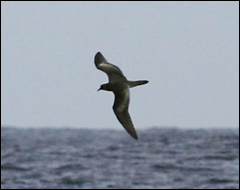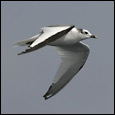
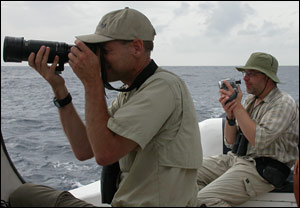 |
| A
full day at sea north off the Cap Vert peninsula. From left: Björn
Johansson and Janne Hägg. Photo: Niklas Holmström, 2005 |
Differences
between pelagics and land-based seawatching
Many birders may consider pelagic trips the foremost way to see and experience
seabirds at close range, which in a way is true when compared to seawatching
from land. However, those who have great experience of land-based seawatching
and are used to certain flight actions and plumages as they are recorded
during prolonged observations from a farther distance, can become frustrated
over the difficult conditions when watching from a ship. The size of the
vessel (ferry, fishing boat or a small game fishing boat) is often crucial
for observation conditions. The comparatively small game fishing boats
of Senegal often offer close views, but at the same time the birds pass
by very quickly and it is often difficult to obtain a clear understanding
and consolidation of their flight styles and jizz, which often is more
easily done when watching from land. Take pelagics as instructive and
happy experiences offering opportunities for first-hand, close-range knowledge
and don't expect all seabirds that may be seen easy to identify, especially
not from a small boat.
 |
| N'Gor Beach and the small island Isle N'Gor in the background. In the foreground
the excellent skipper Gabriel. Photo: Dan Mangsbo, 2003 |
|
|
| Bulwer's
Petrel at sea off N'Gor. Photo: Göran Ekström, 2003 |
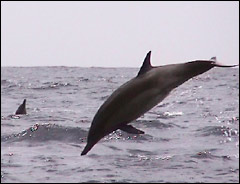 |
| Long-beaked Common Dolphin. Hundreds were seen from land and on pelagics. Photo: Dan Zetterström, 2003. |
When
and where
Besides
a few pelagics during the spring season, which is a less explored time
of the year, most tours have been carried out in the autumn, especially
in October. The best autumn area for pelagics is north-west to north of
the western tip of the Cap Vert peninsula. One apparently productive route
is to travel about two hours towards north-west from the N'Gor Beach,
staying there for a while, then head further north and eastwards (north
of the peninsula), circling around there and ending up with a slow (or
in high speed depending on time left) return back to N'Gor. The British
group has followed this route for years as the Swedish team did in 2003.
The area covered obviously depends on how many hours you charter the boat
for. In a whole day (8 hours) you can cover a much larger area, more distant
from land and over much deeper water, which is important if you want to
have a fair chance to see both Leach's and Madeiran (Band-rumped) Storm-petrel.
My recommendation is to start with a full day at sea at the beginning
of your visit to figure out and learn which species pass west along the
northern coastline. After a full day it is often enough with a few half
days at sea. Even if the skippers are very good as they obviously (without
a word to direct them) know that gatherings of dolphins means schools
and big concentrations of fish that also attracts seabirds, describe the
route for your desired pelagic to the skipper! The skippers, when they
know what you are after, seem to have natural talent for adapting to seawatchers!
In October 2003 the skipper named Gabriel (Atlantic Evasion) was a very
fast-learning man. He was keen to find many small seabirds and drove the
boat in high speed in order to intercept flocks of passing skuas (mostly
Poms)!
One has to bear in mind that a few differences in the British groups´
pelagic ventures between 1995 and 2001 is a result of their directing
the boat towards trawlers off the coast and the productive use of 'chum'.
Since the beginning of 2003 all trawlers are banned within Senegalese
waters. The Swedish (October) and British groups (November) 2003 did not
locate any trawlers except for a few fishing illicitly. For boat companies
that know the secret 'chum' recipes, see West African Sportfishing below.
You will find a compilation of pelagic autumn totals
here»
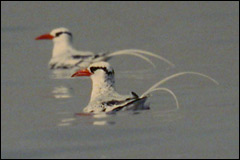 |
| Red-billed Tropicbirds off Madeleine. Photo: Björn Johansson, 1998. |
Iles
de la Madeleine
About four kilometres south-west off Dakar, there are a group
of islands called Madeleine. The National park Madeleine consists of a
main island called Sarpan and two tiny islets. The islands are sometimes
known as Isles of Serpents, which is erroneous as there are no snakes
living on the islands. This is apparently due to a corruption of the name
Sarpan. The most interesting birds here are breeding Bridled Terns and
Red-billed Tropicbirds. The entry fee is about 6 Euro. The owner of the
game fishing company 'Atlantic Evasion' knows the park warden and can
arrange the necessary permissions to land on the main island Sarpan without
an extra fee. However, it is not necessarily to land on Sarpan to see
the Tropicbirds, but laying offshore and scan the islands from the boat,
also round the islands slowly. Several large colonies of (White-breasted)
Great Cormorants is to be found on the main island as well as on the islets.
Species such as Speckled Pigeon and Black Kites is always present on Sarpan.
 |
| Iles de la Madeleine where 1-2 pair of Red-billed Tropicbirds breed. Photo: Martin Oomen, 2005 |
Boat
companies
All boats used for pelagic trips off Dakar and north of the Cap Vert peninsula
are relatively small and constructed for game fishing. However, there
are a few boat companies that cater to the needs of birders. The British
group have more or less exclusively used the Dakar-based game fishing
company 'West African Sportfishing' (WAS), which can do pick-ups at N'Gor
Beach. However, the company seem to be closed down nowadays.
In autumn, 2003 there were problems getting in touch
with WAS, which caused difficulties in planning the pelagic trips for
the Swedish team. But the team discovered that there are many more game
fishing companies in the area and a few located along the N'Gor Beach,
for example "Atlantic Evasion". In 2004 and 2005 both Swedish
groups visiting the area used Atlantic Evasion for all pelagic trips.
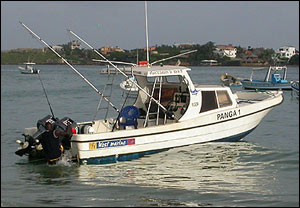 |
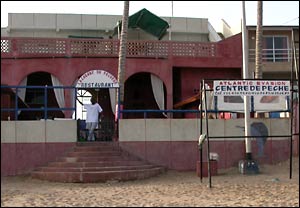 |
|
| One
of the boats belonging to 'Atlantic Evasion'. Most game fishing boats
are similar in size. Photo: Martin Oomen, 2005. |
The
'Atlantic Evasion' office, which also has a good restaurant. Located
on N'Gor Beach. Photo: Niklas Holmström, 2003. |
Atlantic
Evasion
Located on the middle of N'Gor
Beach. It is close to the path leading down to the beach, from which you
will arrive also when heading for Isle N'Gor. Remember to book a boat
a few days in advance, especially if you wish to undertake a boat tour
during the weekend. It is also possible to make a reservation a few weeks
beforehand via email or fax. Each boat takes 4-6 birders and the price
quoted below is the total for the whole boat.
Price
Full day (8 hours): 300 Euro, but the price vary between type of boat
model one choose.
Half day (4 hours): 200 Euro (for example a tour to Isle Madeleine).
Fax: +221 820 75 80
Email: info@atlantic-evasion.com
Web site: www.atlantic-evasion.com
Overfishing
and trawlers
In the last decade, overfishing off the coast of Senegambia has been of
great environmental concern as well as an economic issue. For many centuries
local fishermen harvested the seas off the Atlantic coast and until the
mid 20th century, fishing was a sustainable industry. However, the many
trawlers consuming and depleting the stocks of fish throughout the 90's
have now been stopped. Since 2003 all foreign trawlers are banned within
Senegalese waters, and regardless if you are a seawatcher looking in vain
for presumed trawlers and their following of good birds or just a pelagic
wanderer passing by, this decision will make future generations of both
happy!
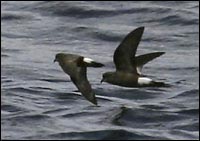 |
| European
and Wilson's Storm-petrel (right) off N'Gor. Photo: Göran Ekström, 2003 |
A
pelegaic trip by Senegal Bird Club
Five intrepid birders set sail on a breezy morning, Saturday,
on 18 November 2000. We set off in a 20-foot fibreglass open skiff with
a 40-horsepower engine and a 15-horsepower "kicker". The captain
used the 15-horse kicker for the two hour trip out to the drop-off of
the continental shelf. We braved ten- to twelve-foot seas. As we left
the harbor, we saw three Great Cormorants. About thirty minutes out, we
saw our first Lesser Black-backed Gulls and Cory's Shearwaters. Another
hour or so later, we saw six trawlers on the horizon. When we reached
the trawlers, we got into mixed flocks of Cory's Shearwaters, Cape Verde
Shearwaters, Great Shearwaters, a few Sooty Shearwaters, European Storm-petrels,
Pomarine Skuas, 'Great' Skuas, Kelp Gulls. We drifted among the birds
for about an hour. As we were heading back, one of the trawlers began
to pull up its nets. The first birds attracted to the rising net were
Common and Roseate Terns. Larger number of Cape Verde Shearwaters and
a fewer Cory's Shearwaters soon joined them. We headed back to N'Gor,
arriving on terra firma at 1:15.
The short pelagic story above is written by Langdon Barone and Ann Gordon, provided by Betsy Hopkins, Dakar.
Copyright © 2004-2012, All rights reserved
